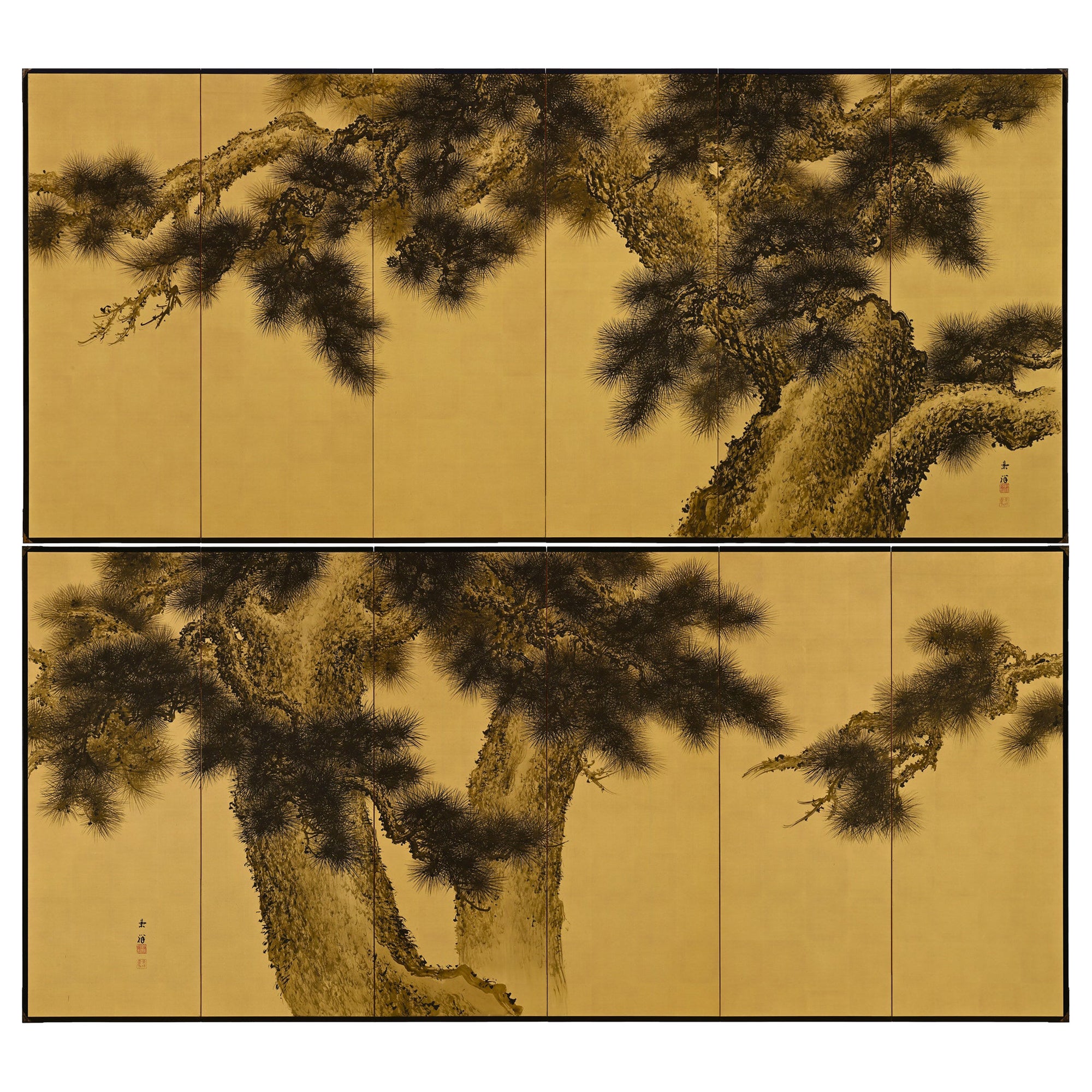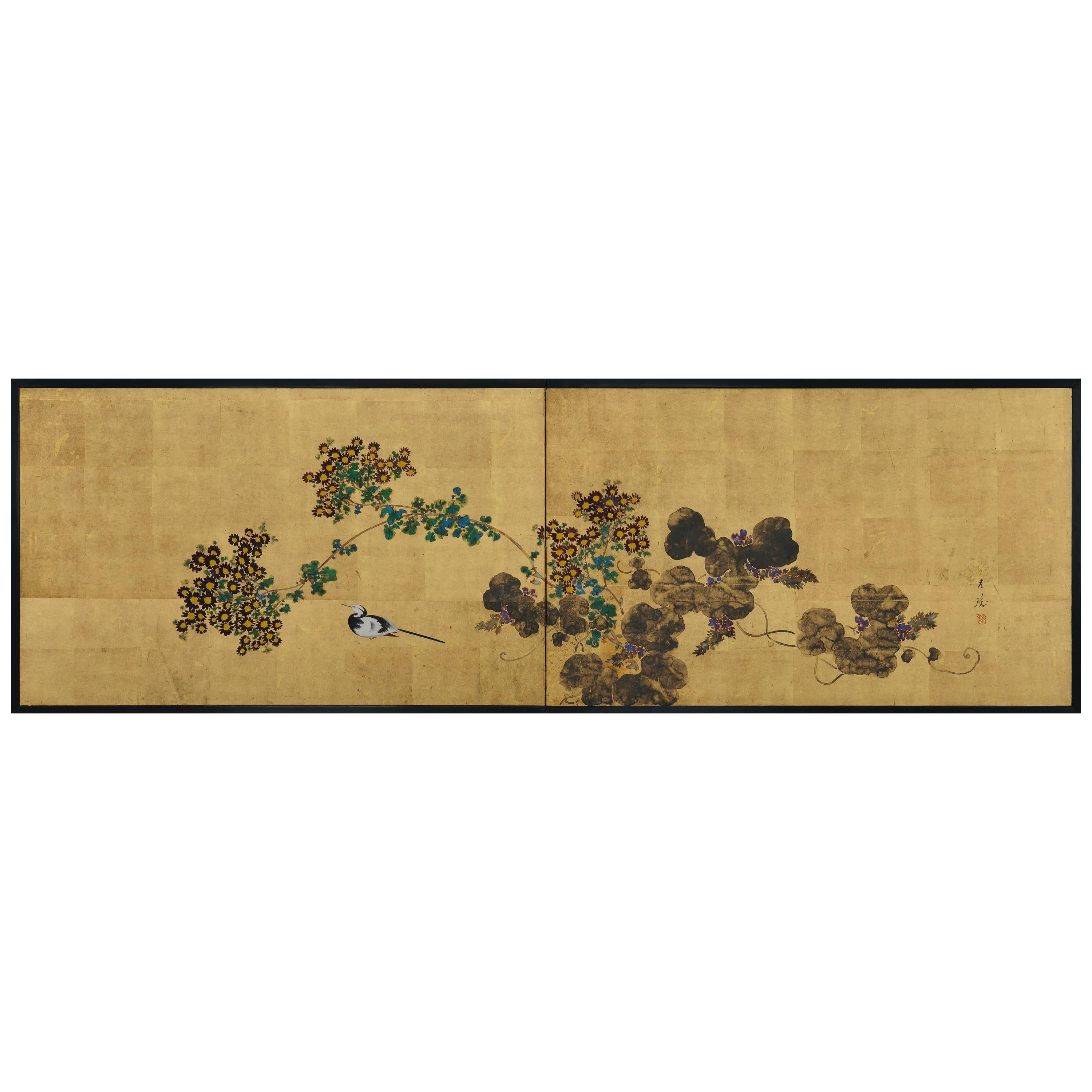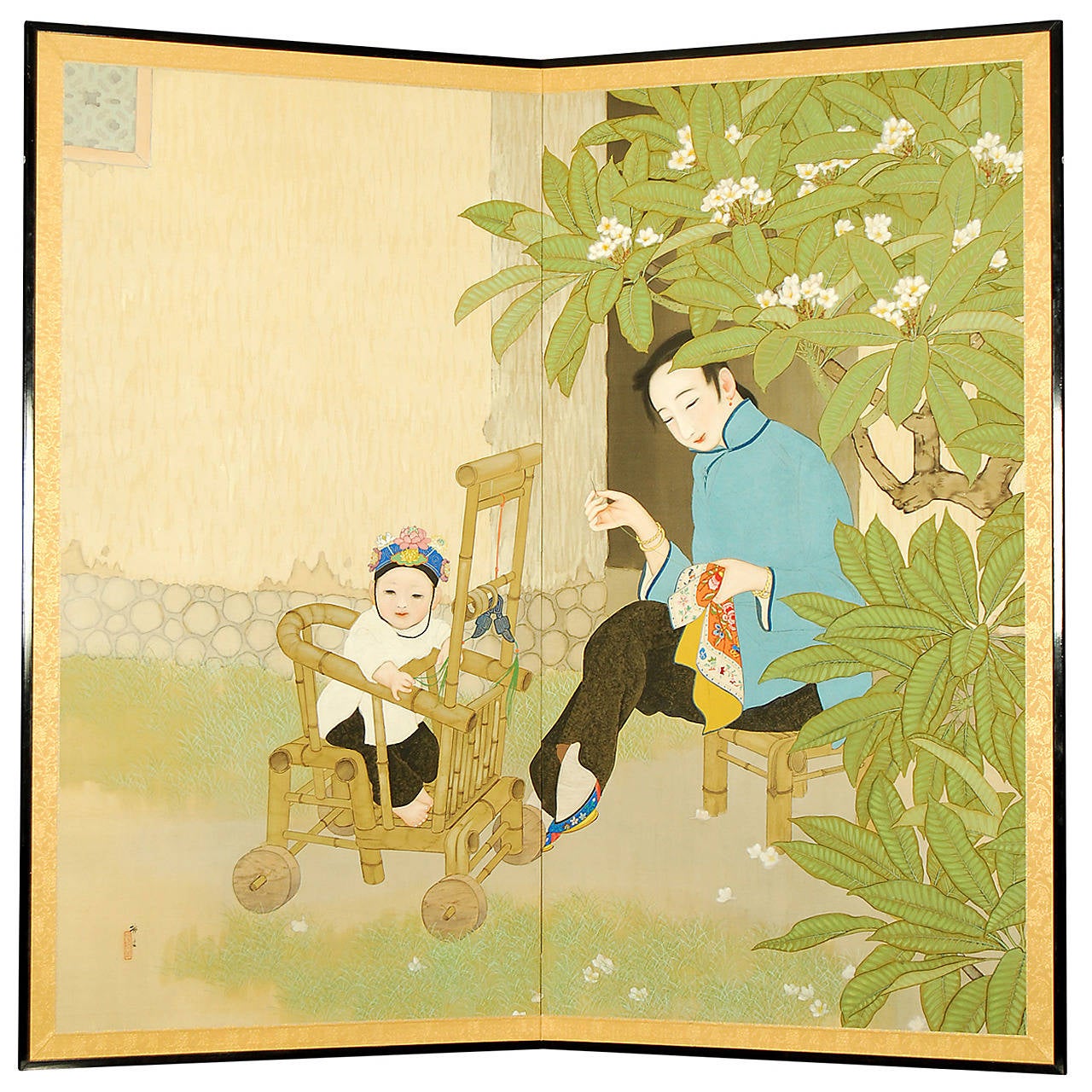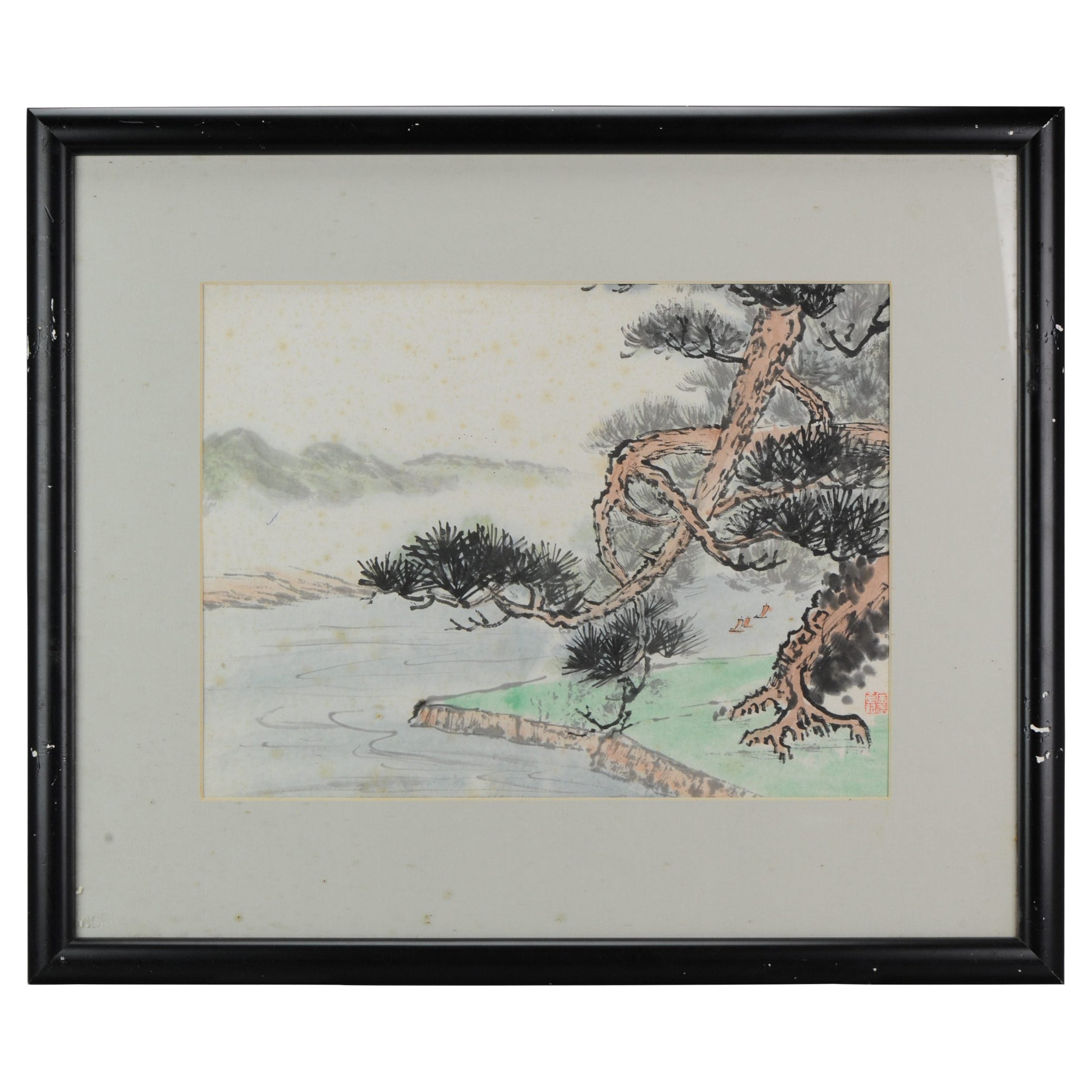Items Similar to Early 20th century classic screen with auspicious trees and shrubs Pine, bamboo
Want more images or videos?
Request additional images or videos from the seller
1 of 13
Early 20th century classic screen with auspicious trees and shrubs Pine, bamboo
About the Item
Early 20th cenrury classic screen with auspicious trees and shrubs
Pine, bamboo, plum and camelia
The evergreen pine is universally known as the symbol of life. During the long and icy winter season, the evergreen does not lose its leaves nor its lush dark green color. This tree has the unique ability to withstand harsh winds and up to subzero temperatures. In Japanese culture, the pine tree is known to represent longevity, good fortune and steadfastness. It is commonly linked with virtue and long life, even immortality. The pine tree is iconic of the Japanese New Year, as a symbol of rebirth, renewal, and a bright (hopeful) future.
Because of its sturdy root structure, it is a symbol of prosperity in Japan. For years, people were told to run into the bamboo groves in the event of an earthquake, because the bamboo's strong root structure would hold the earth together. Simple and unadorned, the bamboo is also symbolic of purity and innocence
The camellia, also known as the tsubaki in Japanese, is a flower species that originates from Asia. It belongs to the family of tea plants and is cultivated extensively in many regions of Japan. In fact, it’s an important symbol of the country, having been used steeped in tradition for centuries. From its bright petals to its sweet nectar-like scent, it’s no wonder why this flower has been admired for so long.
The red camellia has long been a symbol of beauty, grace and perseverance in Japanese culture. Its deep crimson petals evoke the vividness of a fiery sun while its delicate bloom serves to represent the infinite nature of life itself. It has become the embodiment of courage, resilience and strength owing to its fantastic ability to survive and thrive in even the harshest conditions. It is believed that those who wear or carry a red camellia can show their boldness in facing adversity with integrity and grace; thus, this timeless flower carries with it monumental symbolism.
ince ancient times Plum trees, their fruit and delicate, fragrant flowers have been drenched in meaning and mystery. The seemingly humble Plum tree has some amazing stories to tell, branching out from cultures all over the world!
In Chinese philosophy, the Plum tree’s blossom is a symbol of winter ending and a herald of spring. The tree’s pale pink blossoms are cherished because they bloom vibrantly and so bravely amidst the winter chill. They symbolise perseverance and hope, as well as, beauty thriving in adverse circumstances.
As the Plum tree blossoms between two seasons, it is also seen as a symbol of spring - bringing warmth, transition and the promise of fruitfulness. It’s perhaps for this reason that in Chinese mythology it is often written that immortals fed on plums to enhance their strength and vitality throughout the ages.
Japanese tradition holds that the Plum (or ‘ume’) is celebrated as a protective charm against evil, so the ume is traditionally planted in the northeast of the garden, the direction from which evil is believed to come.
- Dimensions:Height: 66.54 in (169 cm)Width: 71.66 in (182 cm)Depth: 0.79 in (2 cm)
- Style:Taisho (Of the Period)
- Materials and Techniques:
- Place of Origin:
- Period:
- Date of Manufacture:Unknown
- Condition:
- Seller Location:Fukuoka, JP
- Reference Number:1stDibs: LU8121239720472
About the Seller
5.0
Platinum Seller
These expertly vetted sellers are 1stDibs' most experienced sellers and are rated highest by our customers.
Established in 1998
1stDibs seller since 2023
36 sales on 1stDibs
Typical response time: 2 hours
- ShippingRetrieving quote...Ships From: Tambon Hang Dong, Thailand
- Return PolicyA return for this item may be initiated within 7 days of delivery.
More From This SellerView All
- 20th Century Japanese Screen by Hiroshi KimuraLocated in Fukuoka, JP20th Century Japanese Screen by Hiroshi Kimura Period: 20th century Size: 187 x 72 cm (74 x 28 inches) SKU: PTA49 This beautiful screen ...Category
20th Century Japanese Showa Paintings and Screens
MaterialsWood
- Late Edo period Tsutsugaki 筒描 Auspicious Shishi Batik ScreenLocated in Fukuoka, JPAuspicious Shishi Batik Screen Period: Late Edo Size: 145x173 cm (57x68 inches) SKU: PTA62 Step into the mythical world of late Edo Japan with our radiant batik screen depicting the...Category
Antique 19th Century Japanese Edo Paintings and Screens
MaterialsCotton, Wood
- Late 18th to Early 19th Century Hawk ScreenLocated in Fukuoka, JPLate 18th to Early 19th Century Hawk Screen Period: Late Edo Size: 372 x 125 cm (146.4 x 49.2 inches) SKU: PTA63 Behold the grandeur of the late Edo per...Category
Antique 18th Century Japanese Edo Paintings and Screens
MaterialsWood, Paper
- Kano school pine screenLocated in Fukuoka, JP18th Century Kano School Pine Screen Delve into the historic brilliance with this majestic gold-leafed screen from the renowned Kano School. The grand green pine, a recurrent motif in Japanese art...Category
Antique 18th Century Japanese Edo Paintings and Screens
MaterialsGold Leaf
- Silk Screen with Gold LeafLocated in Fukuoka, JPSilk Screen with Gold Leaf Period: Taisho-Showa Size: 177 x 188 cm (70 x 74 inches) SKU: PTA31 This beautiful silk screen with gold leaf was created during the Taisho-Showa period ...Category
20th Century Japanese Taisho Paintings and Screens
MaterialsSilk, Wood, Paper
- 17th Century Rinpa School Two-Panel Screen with KoiBy Rimpa SchoolLocated in Fukuoka, JP17th-18th Century Rinpa School Two-Panel Screen Period: 17th-18th century Size: 140 x 125 cm (55 x 49 inches) SKU: PTA43 This beautiful two-panel screen is a classic example of the...Category
Antique 17th Century Japanese Edo Paintings and Screens
MaterialsWood, Paper
You May Also Like
- Early 20th Century Japanese Screen Pair - Ink Pine Trees on GoldLocated in Kyoto, JPImao Keisho (1902-1993) Pine Trees Early 20th Century, Circa 1930 Pair of six-panel Japanese screens. Ink on silk and gold leaf. Dimensions: Each screen H. 67.5” x 148” (172 cm x 376 cm) A pair of monumental six-panel Japanese pine screens by the renowned Nihonga artist Imao Keisho. Here Keisho entirely removed the background and brought the pine trees to the surface of the painting. This simplification of the elements makes the scene exceptionally direct and compelling and injects a very modern...Category
Early 20th Century Japanese Showa Paintings and Screens
MaterialsGold Leaf
- Early 20th Century Pair of Japanese Folding Screens, Deer Under Maple TreesLocated in Kyoto, JPDeer under maples Late Taisho period, circa 1925-1930 Pair of two-panel screens. Ink and pigment on silk. Signature: Goho Seal: Goho A pair of two-fold Japanese silk screens...Category
Vintage 1920s Japanese Taisho Paintings and Screens
MaterialsWood, Paper, Silk
- Early 20th Century Japanese Screen Pair, Fig Trees by Hiroe Kashu 'B.1890'Located in Kyoto, JPFig Trees Hiroe Kashu (b.1890) Taisho era, circa 1920 Pair of six-fold Japanese screens Ink, malachite, gold and silver on paper Dimensions: Each Screen measures H...Category
Early 20th Century Asian Taisho Paintings and Screens
MaterialsGold, Silver
- Japanese Screen, Early 20th Century Wagtail & Chrysanthemum by Ishizaki KoyoLocated in Kyoto, JPIshizaki Koyo (1884-1947) Wagtail & Chrysanthemum Early 20th century Folding screen in two-panels. Ink, pigments and gofun on gold leaf. Sign: Koyo Seal: Koyo This ...Category
Early 20th Century Japanese Taisho Paintings and Screens
MaterialsGold Leaf
- Vintage Japanese Two-Panel Screen, Taisho Period, Early 20th CenturyLocated in Prahran, VictoriaJapanese two-panel screen, study of an Okinawan mother and child, Taisho period early 20th century, dating from the 1920's. Signed by Matsumura Baiso, (1884-1935). Baiso was a studen...Category
Early 20th Century Japanese Taisho Paintings and Screens
- Lovely 19th/Early 20th Century Landscape Painting China Artist Painted Pine TreeLocated in Amsterdam, Noord HollandDescription As you can see, it is a work of landscape, A glance at the Mountains of Heaven. Part of a set of 3 paintings. Condition Overall con...Category
20th Century Chinese Paintings and Screens
MaterialsPaper
Recently Viewed
View AllMore Ways To Browse
Antique Symbols
Tell It Like It Is
Wood Tree Of Life
Plum Tree
Antique Plum
Painting Of Woods And Trees
Antique Mystery
Antique Temperature
Traditional Japanese Painting
Painting Antique Pine Furniture
Pink Bamboo
Antique Lacquer Screen
Bamboo Leaves
Red Asian Screens
Antique Fruit Trees
Tree Asian Screen
Antique Hand Painted Paper Screen
Red Japanese Screens





